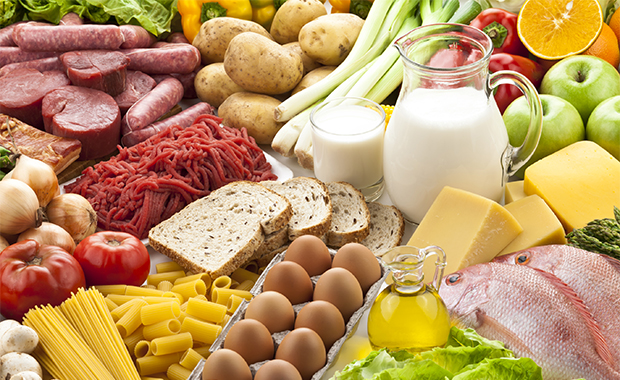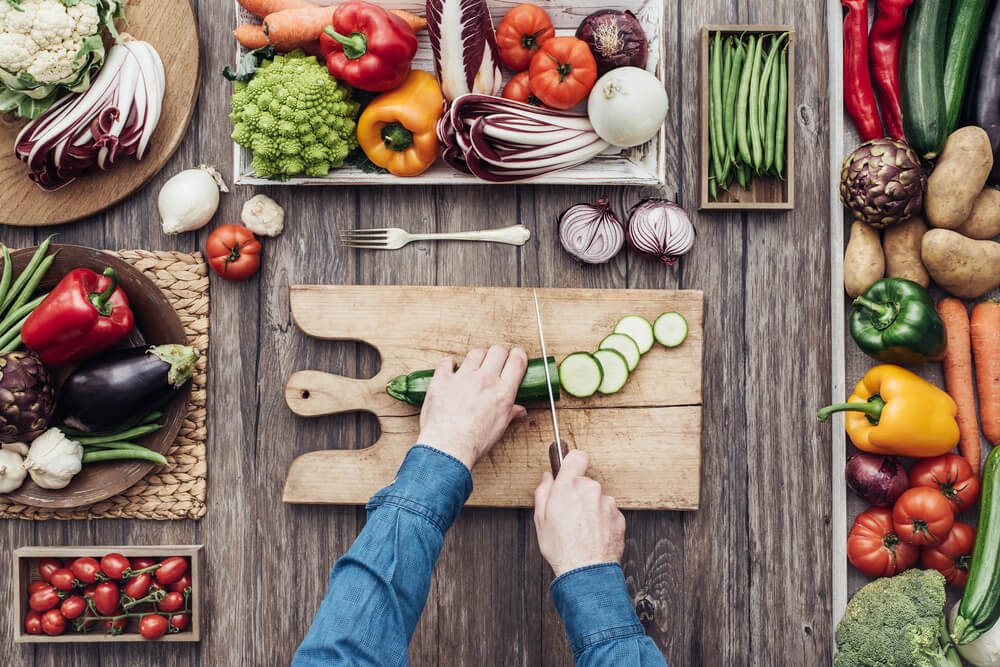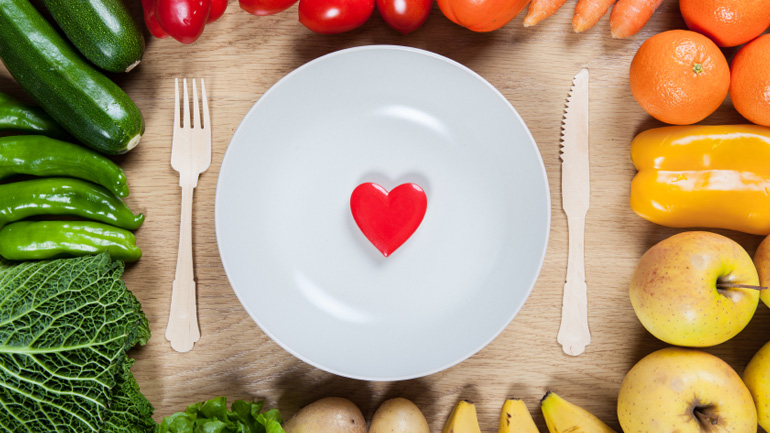Without the energy you get from things like carbohydrates, your blood sugar levels will likely dip which may lead you to feel sluggish and fatigued. And if you let yourself get to hungry, Rachele Pojednic, Ph.D., assistant professor in the nutrition department at Simmons College and professor at the Harvard Extension School, tells SELF that appetite-inducing hormones like ghrelin may even cause you to become shaky or sweaty.
8. Snack more often.
In between meals, go ahead and have a snack. “When you go too long in between meals without eating, it is difficult to go into your next meal in control and avoid overeating,” Julia Levine Axelbaum, R.D., L.D., Bariatric Dietitian at NewStart Clinic, tells SELF. Of course, you’ll want to be thoughtful about the kind of snacks you opt for. She explains that those that are high in protein, fiber, and complex carbohydrates will give you the energy you need to get through the day and keep you satiated from one meal to the next. On the other hand, those that are high in refined carbs and sugar will give you a sudden blood sugar spike that will eventually cause you to crash and feel even more tired.
9. Keep healthy snacks handy.
The easiest way to make sure your inter-meal nibbling stays on track is to have healthy snacks on hand for when hunger strikes. You can keep these nonperishable goodies in your desk drawers, or these energy-boosting nibbles in your gym bag. Simply keeping a bowl of fresh fruit on your kitchen counter will bring your snacking to the next healthy level.
10. Remove the constant temptation of the snack cupboard.
“Resolving to never eat a sweet again takes a lot of effort and can create a feeling of deprivation,” Patricia Bannan, M.S., R.D.N., author of Eat Right When The Time Is Right, tells SELF. “A more realistic resolution would be to create an environment in which you can consume fewer sweets without having to rely solely on your willpower.” If all you have to do is walk to your pantry, you’ll grab a bag and attack it. But let’s say you must put on your shoes, find your keys and drive to the store. Laziness will triumph. (Yes, sometimes sloth is a good thing!)
11. But definitely treat yourself from time to time.
Having a treat now and then is a great way to make sure your healthy eating plan stays on track. Now, you might be thinking, how can eating a piece of cake or a donut help my eating habits? By not making anything completely off limits, registered dietitians explain that you’re less likely to wind up feeling deprived—which means you’re also less likely to find yourself in a binge-eating episode.
12. When fresh fruit isn’t an option, go for the frozen stuff.
Purchasing organic local produce is better for both the environment and your health, but when the nearest farm is hours away, don’t default to a package of Oreos. “Frozen, canned and fresh fruit all have comparable amounts of nutrients,” says Christine M. Bruhm, Ph.D., director of the Center for Consumer Research at the University of California at Davis.
13. Don’t bother with “low-fat” or “diet” versions of foods you love.
When you’re craving Chunky Monkey, no amount of fat-free ice treat will make up for it. “Diet foods leave you feeling hungry and cheated,” says Paul McKenna, Ph.D., author of I Can Make You Thin (Sterling). Splurge on one scoop of the real deal and savor it. “You’ll be satisfied physically and psychologically,” McKenna says.
14. Choose real fruit over “fruit flavor.”
Seeing flavor on a label is a sign the food was stripped of its real taste and a fabricated one swapped in, Bacon says. Natural only means the additive came from a plant or an animal, which may not be as healthy as it sounds. “Scientists create flavors using bacteria and call them ‘natural,'” she says. Would you buy Bacteri-Os?
15. Actually eat dinner at a table.
As much sitting as we do, we rarely stay put during dinner. The less distracted and stressed you are when you dine, the more efficiently your body absorbs nutrients. Turn off the tube, step away from your desk and park the car before you dig in.
16. Watch out for beverages with lots of added sugar.
Brimming with vitamins! Bursting with energy! Store shelves are exploding with colorful, cleverly named drinks that sound healthy but are actually just sweetened water. Don’t let the labels fool you, Berman says. If it’s not plain H2O or regular coffee or tea, it’s a treat. For a healthier sip, try lemon or mint iced tea or sparkling water with a splash of juice.
17. Don’t assume all smoothies are healthy.
“A smoothie with only fruits and fruit juice is essentially dessert!” Rebecca Lewis, in-house R.D. at HelloFresh, tell SELF. Smoothies can definitely be a healthy meal option, provided you’re using vegetables in addition to those fruits, and high-protein, high-fiber ingredients like almond milk and chia seeds. Unfortunately a lot of smoothies (especially store-bought varieties) tend to pack in sugar. In fact, a small size at common smoothie stores like Jamba Juice can often contain more than 50 grams of sugar. To be sure you don’t end up with a total gut bomb, consider making smoothies yourself. Or double check the ingredient list at your favorite shops and supermarkets.
18. Choose meat that hasn’t been processed.
You don’t have to hunt and skin your supper, but if your chicken has been molded into a nugget, who knows what you’re really chewing. And when you choose meat that’s been processed into sausage, strips or slices, you’re downing sodium and preservatives instead of healthy nutrients, says Adam Drewnowski, Ph.D., director of the nutritional sciences program at the University of Washington at Seattle. Stick to unfussed-with cuts straight from the butcher.
19. When grabbing a bite on the go, choose simple snacks.
If all you have time for is a quick snack from the gas station or drugstore, know that you do have options, and if you know what you’re looking for, it will be easier to find. When we asked registered dietitians to recommend snacks to buy at the drugstore, they tended to go for things like nuts and seeds that pack plenty of flavor (hi, wasabi chickpeas), plenty of protein, and not a whole lot else.
20. Cook at home more.
Sure, you could inhale supper straight out of a bucket, but for a healthy meal, you need to invest at least a few minutes in chopping, rinsing or grilling. The result is worth the effort, Mitchell says. “When you prepare dishes yourself, you can see exactly which ingredients are going into it and make conscious choices about what you truly want to eat,” she says.
21. Create a meal plan.
According to Rebecca Clyde, M.S., R.D.N., C.D., blogger at Nourish Nutrition, “A weekly meal plan can help you eat better, save money, and time during the week,” Creating a meal plan on your own, however, can be daunting. Maybe you want to sign up for SELF’s New Year’s Challenge, which includes 40 recipes, along with workouts and so much more.
22. Learn to love meal prep.
Much like planning out your meals, doing meal prep saves you a lot of time—which is super helpful when the going gets busy as hell. When it comes to meal prepping, there are a few things you’ll need to get yourself started: The right storage containers (AKA a sturdy set of BPA-free Tupperware), a well stocked pantry, fridge, and freezer, and a couple hours to spare on Sunday night.
23. Pack up your leftovers right away.
Once you slice and sauté your way to a fabulous feast, you don’t have to finish every bite. “We’re conditioned to think that if we don’t devour everything on our plate, we are misbehaving,” McKenna says. But if you keep munching even after you’re full, you are using your body as a storage unit. If there’s enough left over for lunch tomorrow, pack it up and put it in the fridge. Otherwise, toss scraps in the trash. We promise we won’t tell your mom.
24. Turn one meal into many.
Think of it like planning for leftovers. If you’re going to make yourself dinner anyway, why not stretch it to get you through lunch a couple days this week, too? Here are some basic tips for turning one easy meal into a week’s worth of lunches. Need more inspiration? Try these 17 dinners that make perfect lunch leftovers.
25. Cut yourself a break!
If you follow these rules most of the time but occasionally crave a fast food fix, a slice of pizza or a brownie, go for it. Enjoying your food isn’t an exception to a healthy eating plan—it’s an integral part. “We all have to relax a bit,” Drewnowski says. “If you want fried chicken now and then, enjoy it!”





